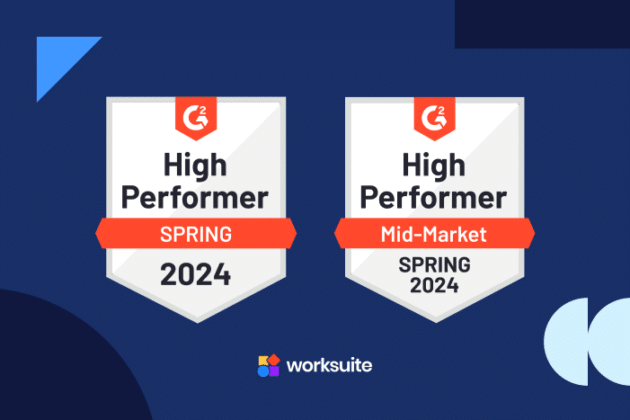
1099 vs. W-2 Workers: How to Hire and Engage U.S. Talent Compliantly


W-2 vs. 1099: It might sound like a teeny-tiny difference, but getting these two confused can lead to serious penalties. We’re talking fines, back pay, lawsuits, government investigations, and even jail time. It’s critical to make the right determination between your 1099 contractors and W-2 employees, and avoid misclassification risk.
Hiring compliantly in the U.S. is hard — regardless of whether you’re a U.S.-based company or an international business. Federal laws can be stringent enough, and there are state-specific laws to make things even more tricky.
Fortunately, you don’t have to roll the dice to legally hire full-time employees and contract workers in the United States. At Worksuite, we’ll give you the tools and know-how to build your workforce compliantly.
Why trust us? Notably, we’ve had zero misclassification issues with our clients and 350,000+ talent since starting Worksuite in 2015. With Worksuite’s Global Engage compliance services, 1099 vs. W-2 classifications (among other things) are our bread and butter. You can count on us to give you the proper strategic guidance.
Scroll down for a helpful infographic summing up what you need to know about 1099 vs. W-2 workers.
W-2 vs. 1099: Why Does It Matter?
The classification of workers as 1099 or W-2 matters, both for you and your workers. Here’s why:
For Employers:
- Legal Compliance: Misclassifying workers can lead to legal penalties and owing back pay to the misclassified workers.
- Tax Obligations: Employers have different tax responsibilities for W-2 and 1099 workers. Proper tax withholding, reporting, and payment are essential to avoid penalties and guarantee accurate tax compliance.
- Employee Benefits: W-2 workers are often entitled to benefits such as health insurance, retirement plans, and paid time off. Misclassifying workers as 1099 could lead to legal claims for denied benefits.
- Labor Protections: W-2 workers are protected by labor laws regarding minimum wage, overtime pay, workers’ compensation, and other rights. Misclassified workers may be denied these protections.
- Government Audits: Employers could face audits and investigations by government agencies to verify worker classification.
For Workers:
- Employee Rights: W-2 employees are entitled to various employment rights and protections that 1099 workers may not have, including minimum wage, overtime pay, and employee benefits.
- Tax Responsibility: W-2 workers have taxes withheld from their paychecks, while 1099 workers are responsible for paying their own taxes. Misclassification could lead to unexpected tax liabilities.
- Benefit Eligibility: W-2 workers may have access to benefits such as health insurance, retirement plans, and paid leave. 1099 workers are generally responsible for their own benefits.
- Contractual Clarity: Worker classification affects the terms of engagement, including contract details, payment terms, and expectations.
A U.S. Department of Labor commissioned report found at least 30% of employers (and probably more) have misclassified workers, affecting millions of employees. Some of these misclassifications are innocent mistakes, while others are known attempts to dodge tax responsibilities and paying for employee benefits.
Either way, it’s illegal to misclassify, and it can land your company (and you) in deep water. Let’s get on the same page about what a 1099 contractor is vs. a W-2 employee — and then we can highlight the primary differences to help you hire and engage talent by the book.
What Is a 1099 Contractor?
1099 workers are independent contractors who receive payments from companies through Form 1099-MISC or Form 1099-NEC. These self-employed individuals (or business entities) provide goods or services to businesses through an independent business relationship rather than full-time employment.
You might find 1099 contractors with any of the following labels:
- Contractors
- Freelancers
- Consultants
- Gig workers
- Self-employed professionals
- Vendors
1099 workers have greater control over how they work. They often provide their own hardware, software, and tools, and they might work with multiple clients simultaneously.
Your business doesn’t withhold taxes from contractor payments. Instead, you’ll report the total amount paid to the contractor on your 1099 form — it’s the contractor’s responsibility to report this income and pay the appropriate taxes.
What Is a W-2 Employee?
W-2 employees are full-time employees who receive a Form W-2 from their employer at the end of the tax year. Your W-2 employees have a formal employment relationship with your company. As the employer, you determine their tasks, work schedules, and job responsibilities, and you also tend to provide all the hardware and software they need to do their jobs.
It’s your responsibility to withhold federal and state income taxes, Social Security taxes, and Medicare taxes from your employee’s wages. You’ll also usually provide benefits such as health insurance, retirement plans, paid time off (PTO), as well as other perks.
W-2 employees receive labor protections and benefits from federal and state laws. These include:
- Minimum wage
- Overtime pay
- Worker’s compensation
- Unemployment benefits
- Equal pay
- Safe workplaces
What Are the Primary Differences Between 1099 vs. W-2 Workers?
Classifying your workers as 1099 contractors vs. W-2 employees isn’t arbitrary. It’s based on legal criteria determined by the work arrangements, control exerted by the employer, and other factors about when and how the work gets done.
Here are a few of the primary differences to keep in mind when classifying your employees:
Employment Relationship
W-2 employees tend to only work for one business (as defined in their employment contract). 1099 contractors typically have the freedom to work for as many clients as they want.
Tax Withholdings
Businesses are responsible for withholding and paying taxes for their W-2 employees, but 1099 contractors must calculate, withhold, and pay their own taxes.
Pay
Employee payroll is typically hourly or on a fixed salary. Whereas, a client only pays a 1099 freelancer in exchange for the hours worked or tasks completed.
Payment models to 1099 contractors can come in various forms:
- Hourly rate
- Day rate (common for video production and specialized technicians)
- Project fee or Package model (common in creative service industries)
- Per-article rate (used in publishing; very similar to Project fee)
- Monthly retainer (mainly used in legal, financial services, and advertising agencies)
- Performance model (primarily used in paid media, SEO, advertising, ecommerce)
Related: Want to simplify and streamline your contractor payments in up to 120 currencies? Learn more about Worksuite Global Pay.
That said, the main difference between employee pay and contractor pay is that the employee is on a fixed salary that gets paid year-round, even while they’re sick or on vacation. The contractor only gets paid while they’re working.
Benefits
W-2 employees tend to receive employment benefits such as health insurance, retirement plans, and paid time off. 1099 contractors aren’t entitled to these benefits — they must provide (and pay for) their own.
Control and Independence
Employers can control their W-2 employees’ work, tasks, schedules, processes, and tools. The IRS defines a full-time employee as someone who works on average at least 30 hours of service per week, or 130 hours of service per month.
1099 contractors, on the other hand, have more control over when and how they get the job done. They determine their own flexible work schedules, and typically deliver projects based on an agreed-upon scope in their contractor agreement.
Labor Laws and Protections
W-2 employees are legally entitled to specific employment protections, but 1099 contractors are not. The nuances of these labor laws vary by state and territory. Some examples of labor laws that protect employees’ rights include:
- Paid Sick Leave – Certain states require employers to provide paid sick leave or earned sick time off to eligible employees.
- Minimum Wage – Beyond the federally required minimum wage (still $7.25 as of this writing), each state has its own unique minimum wage requirement. For example, New York minimum wage ranges from $13.20 to $15.00 per hour depending on location and employer size.
- Meal and Rest Breaks – Many U.S. states have nuanced laws when it comes to meal and rest breaks. For example, the Department of Labor requires at least a 30 minute meal break for any 6+ hour workday in New York, Maine, Maryland, Oregon and Tennessee. In Puerto Rico, the law requires a one-hour break if the work period is longer than 5 consecutive hours.
- Ban the Box Law – Some states have a “Ban the Box” law which prevents employers from asking workers about any prior criminal convictions until later in the hiring process.
- Reporting Time Pay – In certain states, if the employee reports to work but is sent home because there is no work to be done, they may be entitled to a certain number of hours of “call-in pay.” California, Connecticut, Massachusetts, New Hampshire, New Jersey, New York, Rhode Island and Washington, D.C. all have reporting time pay laws.ass
- Temporary Disability Insurance – A few states like Massachusetts require benefits coverage for non-permanent, job-related injuries that leave you unable to work for a certain amount of time.
Related: Want to hire and engage top talent in all 50 United States and up to 190 countries, the right way? Learn more about Worksuite Global Engage strategic compliance services.
How to Avoid Misclassification
First and foremost, you need to understand the specific laws and tests that state and federal governments use to determine employment classification. Let’s start with the two most-used tests:
- Common Law Test
- ABC Test
Common Law Test
The Internal Revenue Service (IRS) and dozens of states use the Common Law test (also known as the 20-Factor Test) to evaluate the nature of an employment relationship. It primarily looks at three main categories:
- Behavioral Control: Does the employer control where, when, or how work is completed?
- Financial Control: Do you reimburse the worker’s expenses? Do you provide the hardware, software, and facilities for your employee? Is the employee free to offer services to other clients on the open market?
- Relationship: How is the work described in your written contract? Do you provide your worker with benefits? How long is the contract for?
If an employer has any of these controls over a worker, the worker should be classified as an employee.
ABC Test
The U.S. Department of Labor (and over 30 states) use the ABC Test to determine a worker’s employment status:
- Absence of Control: The worker is free from the control and direction of the hiring entity.
- Business of Worker: The worker performs work outside the usual course of the hiring entity’s business.
- Customarily Engaged: The worker regularly works as an independent contractor in this trade.
It’s important to understand these criteria, as the burden of proof now falls on the employer to prove that workers are in fact independent contractors.
Many states have built their own laws and tests. Most are built upon these same principles, but the nuances can significantly affect employment classification.
For example, California has adopted a more stringent Dynamex ABC Test. Massachusetts emphasizes whether the contractor has an independently established business. New York uses a “Right to Control Test” to look at control, supervision, and independence. Wisconsin employs a “Circuit Court Test” to look at payment methods, equipment furnishing, and the right to discharge.
Each state is different, so you’ll need to do your research and due diligence to avoid misclassification (and the penalties that come with it). That’s where a platform like Worksuite comes in handy—we make it easy to identify compliance issues and classify employees appropriately, regardless of where they’re located in the United States or worldwide.
Must-Do Checklist to Avoid Misclassification
It’s best to work with legal and financial counsel to cover all your bases, but here’s a quick checklist to help you avoid misclassification:
- Regularly Review Your Workforce: Check your current engagements and contracts to ensure compliance. Roles and responsibilities sometimes evolve with time, and an independent contractor last year might be more appropriately classified as a W-2 employee this year.
- Stay Up-to-Date on Labor Laws: Labor laws evolve. Brush up regularly on changing regulations to ensure your workforce stays compliant.
- Hire an EOR or AOR: Employer of Record (EOR) or an Agent of Record (AOR) are third-party organizations that ensure legal and financial compliance. Worksuite provides end-to-end management services to ensure ongoing compliance and risk mitigation.
- Get Legal Help on Your Contracts (and Expectations): Get experts to help outline the terms of engagement, scope of work, and contract verbiage.
Real-Life Examples of Getting 1099 vs. W-2 Wrong
Misclassification is expensive — not to mention, wrongful to employees. It can result in serious fines and penalties, as these companies experienced:
- Nike: The world-famous athletic apparel giant that employs 79,000 people globally is recently under fire for misclassifying thousands of temporary office workers, facing $530 million in potential tax fines.
- Uber: Food delivery gig companies (Uber, Golvo, Just Eat, and Deliveroo) in Italy were forced to pay €733 million in fines due to misclassifying workers.
- Drywall and Framing LLC: The owner of this Pennsylvania construction firm was sentenced to 23 months of time with one year of consecutive probation for misclassifying workers to avoid paying taxes.
- Staffing Agencies: In 2013, a staffing company was found in misclassification after using 1099 contractors to help clients with marketing events that needed extra staff for promotional support.
- San Diego Union Tribune: The newspaper publisher was ordered to pay $11 million for the misclassification of its paper carriers as independent contractors.
Hire in the U.S. With Confidence
Whether you want to hire locally or internationally, Worksuite has you covered. Worksuite Global Engage helps keep you compliant by finding contractors, creating compliant contracts, and classifying workers appropriately — all backed up by a bespoke certification for engagement in the country of the contractor’s tax residency.

See Worksuite Global Engage in action, classify correctly, and shield your business from compliance risk when scaling your team.
Book a callRelated Articles
Hire and engage top talent with ease.
Learn how Worksuite keeps you compliant and transforms your workforce management.






